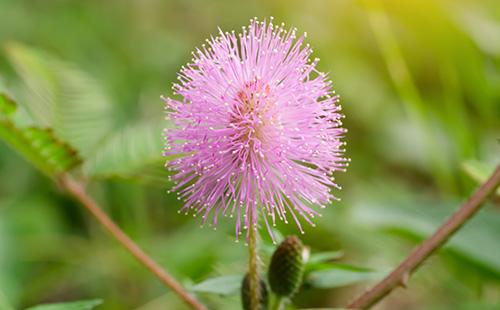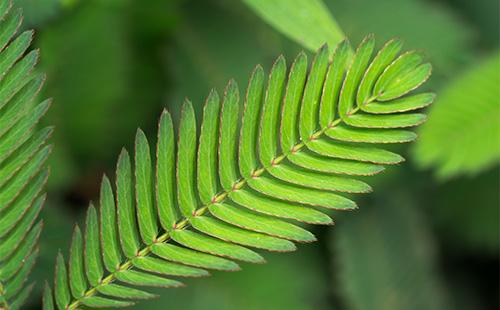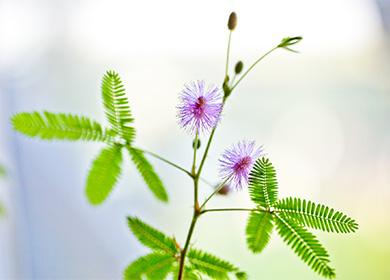The content of the article
The native habitat of this shrub is the Brazilian tropics. In nature, bashful mimosa grows up to 1.5 m. And on window sills and winter gardens - up to a maximum of 50 cm. The plant belongs to the genus mimosa, and to the legume family. Mimosa bashful - a perennial plant. But at the same time it does not live long, because of which it is often called an annual. But this shrub never spares seeds. Using them, you can easily propagate the "Princess and the Pea."
As far back as the 18th century, the French researcher and astronomer Jean-Jacques Dorte de Meran noted that the shy mimosa moves leaves and changes their orientation every 22 hours. In addition, any effect of external stimuli on the shrub responds in it by twisting the leaf blade. And this feature is another reason why experienced flower growers, despite all the difficulties and ups and downs, take it with great pleasure to grow shy mimosa at home.
Why is beauty ashamed
This fragile shrub got its unusual name due to the ability to instantly respond to rain, wind and the touch of living creatures - including humans. This is the answer to the question of why the leaves of a mimosa are bashful. It is enough just to touch the plant slightly, as it immediately twists its foliage, as if defending itself from external influences. After half an hour, the sheet straightens and restores its usual position.
As for the periodic change in the orientation of foliage, in the course of research it was found out - this phenomenon is in no way connected with the change of day and night. According to botanists, the blame for all the internal biorhythms of the plant itself.
Mimosa care bashful home
Mimosa shy - a child of the tropics. This fact is the basis of plant care. In order for the bush to live comfortably and comfortably in the apartment, the grower needs to create conditions resembling a tropical climate. Here are three pillars on which care for a bashful mimosa during flowering is based:
- lack of cold and draft;
- high humidity;
- minimum external stimuli.
Where to put the pot
The domesticated tropical shrub is not at all afraid of the sun. And, on the contrary, it is ready to absorb the sun's rays with every cell of its leaves. He loves plentiful and bright lighting.If you don’t know how to take care of a shy mimosa after a purchase, first select a location for it based on the information in the table.
Table - Locating a mimosa in an apartment
| Type of climate in the region of residence | Desired side of the world |
|---|---|
| Subtropical | - East; - west |
| Moderate sea | - southeast |
| Moderate continental | - South |
Optimum temperature
The optimal temperature for growing shy mimosa differs depending on the time of year. In summer, the thermometer should show about 22-23 ° C. In winter - fluctuate around 15-17 ° C. By the way, at a time when creaky frosts are standing outside the window, it is better to move the flowering beauty to the southern windowsill.
Humidity
The gentle beauty-mimosa is happy to breathe air, the moisture content of which varies from 75 to 85%. There are three ways to achieve your desired moisture level.
- Aquarium. If the house has an aquarium, the pot can be placed next door. Humidity near the water tank will be sufficient to ensure that the plant develops quietly.
- A tray with water. A mimosa pot can be installed next to a wide tray or tray of water. Nearby, but not into it! However, in the interior, this bulky design does not always look aesthetically pleasing.
- Spraying. Periodic irrigation from the spray of the room in which the mimosa is bashful is another option for solving the problem. It is important to ensure that drops of water do not fall on the plant itself.

How to water
When the mimosa blooms (and this happens from mid-March to the end of October), watering should be moderate, but frequent. On average, it is enough to water a shy mimosa once every two days, using clean, settled water for irrigation. If you notice that the topsoil in the pot is completely dry, moisten the substrate.
Do I need to transplant
The question of how to transplant shy mimosa into another pot and whether it is necessary is especially relevant. Professionals believe that the plant is perennial. But this opinion is criticized, and a modest mimosa is sometimes referred to as annuals - according to this logic, it does not need a transplant ... As a result, if desired, and at its discretion, flower growers simply gently remove the “pink princess” from the pot along with the turf, avoiding its scattering , and actually "rearrange" in another capacity. This method is also called transshipment. It is not necessary to change the substrate or supplement it with something.
How and what to fertilize
A shy mimosa needs fertilizer exclusively during the growing season. That is, when the plant is actively developing in a pot and blooms. Mimosa needs to be fertilized twice a month: at the beginning and at the end. Preparing top dressing is not difficult. We breed universal fertilizer for indoor flowers in a 1: 1 ratio and use the resulting solution when watering.

Secrets of breeding the "pink princess"
We figured out how to care for a shy mimosa. But how to plant this quivering bush with inflorescences similar to pink fluffy pompons made of thin synthetic threads?
Pollination
A grower who wants to get “offspring” from a shy plant will have to work a little with a bee. There are two ways of pollination of mimosa.Each of them can be easily applied in an apartment or house.
- Direct contact. Carefully take two inflorescences of the bush and barely touch them with each other. We produce the action as carefully as possible so that the plant does not experience stress.
- With a brush. “Armed” with the smallest paint brush. With its help, we take pollen from one inflorescence and transfer it to another.
Seed preparation and planting
Theoretically, a shy plant can be propagated in two other ways - by cuttings or by planting seeds. However, grafting is an ineffective method. But to grow bashful mimosa from seeds is much easier. Seeds for planting can be bought or removed from a dried pod - the fruit of a mimosa. "Harvesting" falls in mid-autumn. Therefore, having taken out the seeds, they must be sent to the refrigerator. They will be needed no earlier than in March. This spring month is considered the best time for sowing.
Reviews of experienced gardeners indicate that before setting the seeds in the substrate, they need to be soaked in water for half an hour. A resident of the Brazilian tropics, who migrated to our windowsills, appreciates light soil. There is nothing complicated in preparing the perfect substrate. We take one part of the turf, peat soil and sand - that's it. Do not forget to organize high-quality drainage and safely plant, guided by the following four-step instruction.
- We plant the seeds. Sprinkle them with a small layer of earth and cover with polyethylene to create a greenhouse effect.
- We are waiting for seedlings. When periodically airing the "flower bed" and spraying the substrate, a month later we observe the first, weak results of our work.
- We remove the film. As soon as the sprouts hatch, we remove the film from the pot.
- We are planting. After the appearance of at least three leaves on the mimosa, the future beauty is planted from the sisters in a separate container.
Causes of disease
It can not be said that the capricious southerner is sick more often than other indoor representatives of the flora. However, misfortunes do happen from time to time. Symptoms of some diseases appear on the foliage when the bashful mimosa turns yellow. Other diseases do not allow the plant to bloom or modify the stems of the bush. The following table will help you recognize the signs and causes of the deterioration of the plant.
Table - Common problems with growing mimosa and their causes
| Problem | Cause |
|---|---|
| Leaves fall | - Inadequate or irregular watering |
| Leaves turn yellow | - Accumulation of excessive moisture in the substrate |
| Stretched stalk | - lack of sunlight |
| No bloom | - Lack of sunlight; - cold |

Pests and ways to deal with them
The most common pests that prevent the "pink princess" from living and blooming normally are spider mites and aphids.
We defeat aphids
Features Aphids are a large parasite. And in order to rid the houseplant from the expansion of this pest, it is necessary, first of all, to resort to mechanical cleaning.
Action algorithm
- Eliminate the affected aphids of the shy mimosa (break off the leaves).
- We apply spraying with means containing Permethrin - an insecticide and acaricide.
- With total aphid damage, repeat the “chemical attack” after three to four days.
Get rid of the spider mite
Features If a lesion is detected by this pest at the initial stage, chemical treatment can be dispensed with. The highest risk of damage to the bush by a spider mite in the summer. These insects adore heat and feel in hot, dry rooms, like a fish in water.
Action algorithm
- Using spraying with a soap solution, we process the leaves and stems affected by the pest.
- Spray the affected area with a solution of any insecticide.
Growing bashful mimosa at home is a very exciting process, especially for beginner growers.Recent studies in the field of botany prove a fact that has been floating in the air for a long time: “shy beauty” has intelligence! It turns out that a tropical bush easily distinguishes living beings from inanimate objects and remembers the properties of those with whom it is in contact. If the phenomenon, object or living creature does not pose a threat to the flower, then the next time it will not spend energy on twisting the mimosa leaf.
Reviews: "Tender and vulnerable lady"
My daughter and I have been growing Mimosa shy for several years, just a charm and not a plant, I bought the child from the fact that Anyuta wanted to grow something, the seller of the store advised Mimosa, and what a miracle, the seeds came out right away, 10 planted 10 and it came out, and then there are no problems when the daughter remembers then and will pour, for the winter we cut off the stems that have grown over and a few days later new shoots appear on them, and the mimosa grows for another year and makes us happy. And what a pleasure it gives the child to touch her and watch how the leaves close and open, we even timed for how much she closes and opens.
Vera, http://www.botanichka.ru/blog/2010/05/14/mimosa-pudica/
This is a plain-looking plant, but when you touch its petals, you understand the opposite, it is so interesting and funny. It touches you when touched! And folds his leaves. I bought seeds to grow it in an ordinary flower shop, for only 15 rubles !!! Scaled the seeds with boiling water (recommendation on the package). Planted in a recess in a peat tablet. After 4 days, seedlings already appeared :) Over time, the bush grew and decided to transplant it into a pot of land.
When transplanting, I was surprised that it has a very small root system, and it could have existed even in a tablet, probably half a year :) I recommend you not to overdry and not fill the plant, because the leaves immediately fall off. I grow it in plain earth mixed with a peat tablet. No drainage. At night, the bush closes its leaves. In the morning, opens and reaches for the sun. If you buy seeds once, then when grown, you will never need to buy seeds again because when it blooms, it gives a lot of seeds. I consider an annual plant. It is better to plant it every year, in February, and it will delight you with fresh leaves until January :)ZanoZzzA, http://irecommend.ru/content/obizhulka-nasha
Hello. Recently, I came across seeds of mimosa, and I decided to buy them, because I know that Mimosa is a very interesting plant. Out of 14 seeds (2 packs), only 8 mimosas emerged. Mimosa is a very tender plant, if it is slightly touched or the wind blows, it begins to fold its leaves, and, as it were, hides. It blooms with magnificent circles, it will be very interesting for a child to watch this flower. Mimosa also grows well with a few little things in a pot, do not touch it as often, otherwise it may die. Mimosa has already been transplanted into the pot more, we can say that it is also resistant to transplantation, but once again it is better not to transplant it, yet it is very tender and vulnerable. If you want to interest a child with flowers, I think it's worth starting with Mimosa bashful.
fradgirl, http://otzovik.com/review_4932678.html

